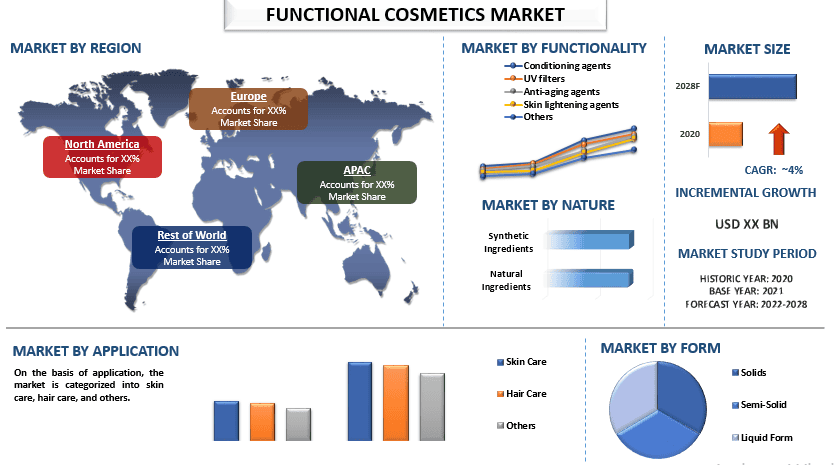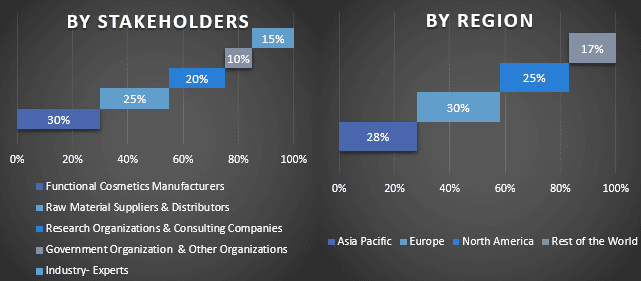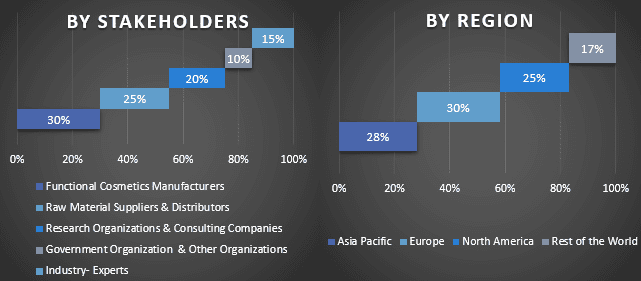Emphasis on Functionality (Conditioning agents, UV filters, Anti-aging agents, Skin lightening agents, and Others); Nature (Natural Ingredients and Synthetic Ingredients); Form (Solids, Semi-Solid, Liquid Form); Application (Skin Care, Hair Care, and Others); and Region/Country

Global Functional Cosmetics Market is expected to grow at a significant rate of around 4% during the forecast period. Functional cosmetics are special types of chemicals that are majorly used for cosmetic skincare products to help improve their functional properties. The products that are used on the skin to cleanse, enhance, or make the face and body more appealing. In addition, Functional cosmetics demand is rising as young people and millennials become more conscious of the need to maintain healthy skin and hair. In recent years, the utilization of organic goods in the skincare industry has had a revolutionary impact on the market’s current growth. Hence, these items are frequently utilized by individuals of all ages. Also, cosmetics are so widely accessible in supermarkets, pharmacies, beauty parlors, and online, cosmetic products globally. Major companies in the market are launching different functional cosmetics products for hair and skin care. For instance, Garnier launched the product named Garnier Fructis Hair Food Range for tackling dry and damaged hair. The product is also available in various variants such as Banana, Papaya, Aloe Vera, and Macadamia.
Croda International plc, Evonik Industries AG, Gattefossé SAS, Givaudan, Unilever plc, L’Oréal S.A, The Estée Lauder Companies Inc, BASF SE, Clariant AG, Stepan Company are some of the key players in the market. Several M&As along with partnerships have been undertaken by these players to facilitate customers with hi-tech and innovative products/technologies.
Insights Presented in the Report
“Amongst functionality, conditioning agent’s category witnessed the highest CAGR during the forecast period”
Based on functionality, the market is segmented into conditioning agents, UV filters, anti-aging agents, skin-lightening agents, and others. The conditioning agent’s category witnessed the highest CAGR during the forecast period owing to the growing influence of the skin on the homeostatic process of repair and growth by augmenting the skin’s renewal mechanism. Conditioning agents can help in temporarily improving the cosmetic appearance of damaged hair which further needs to be reapplied as the removal occurs. Furthermore, the increasing population and rising per capita spending on cosmetics in Asia-Pacific and Europe are adding to the growth of the market. For instance, Function of Beauty has expanded into the United Kingdom at beauty e-retailer Cult Beauty. It is offering personalized treatments to consumers.
“Amongst application, skincare to hold a significant share in the market in 2020”
On the basis of nature, the market is categorized into natural ingredients and synthetic ingredients. Among these, natural ingredients to hold a significant share of the market in 2020. This is mainly due to the shift towards natural and clean-label cosmetic products by consumers across the globe. As natural products do not have health side effects and are mild and gentle to feel on the consumer’s body. Additionally, many major players are introducing new products in the market to fulfill consumer demand. For instance, in April 2020, Nouryon introduced a natural polymer for sunscreen formulation.
“Amongst functionality, conditioning agent’s category witnessed the highest CAGR during the forecast period”
Based on form, the market is segmented into solids, semi-solid, and liquid forms. The liquid forms category witnessed the highest CAGR during the forecast period because they are easy to apply to the body as they are present in many different forms such as gels, ointments, lotions, creams, and other forms as compared to other forms. In addition, on average beauty products contain from 60% to 85% water. For example, Rinse-off products, such as hair care, shower gels, or cleansers, contain up to 95% water, while bar soaps and some make-up products may contain only traces or none at all which increases the demand for liquid-based products in the market. For instance, in Aug 2022, Kao launched their first liquid-based supplement product under the skincare, cosmetic brand products in Japan.
“Amongst application, skincare to hold a significant share in the market in 2020”
On the basis of application, the market is categorized into skincare, haircare, and others. Among these, skincare to hold a significant share of the market in 2020. This is mainly due to the advantages skin care offers as compared to its counterparts. caters to problems such as protection from harmful sun rays, wrinkles, blemishes, acne, aging, and frown lines, among others. Skincare products are widely in demand across the world due to the common need of humans to look good. The essence of bright and glowing skin is a major thriving factor in the growing demand for beauty and skincare products. An increase in male-specific cosmetic products and a growing population globally is expected to boost the demand for skin care cosmetic products, thereby increasing the demand for functional cosmetics used in these products.
“Europe to hold a significant share in the market”
In 2020, Europe is anticipated to grow at a substantial CAGR during the forecast period. This is mainly due to the increasing production and consumption of functional cosmetics backed by growing disposable income and surging per capita spending of individuals in the emerging economies of the region is driving the growth of the market. Moreover, the preference for natural and organic personal care items as well as quickly biodegradable products is further expected to support the market growth. In addition, Germany is also anticipated to be a highly attractive country in the functional cosmetics market for skin care applications in Europe during the forecast period. The rising usage of functional cosmetics by certain age groups is witnessing strong growth, owing to the increase in skin-related issues. This is augmenting the functional cosmetics market for skin care applications in Germany which is further expected to drive the functional cosmetics market in Europe.
Reasons to buy this report:
Customization Options:
The Global Functional Cosmetics Market can further be customized as per the requirement or any other market segment. Besides this, UMI understands that you may have your own business needs, hence feel free to connect with us to get a report that completely suits your requirements.
1. Market Introduction
2. Research Methodology Or Assumption
3. Market Synopsis
4. Executive Summary
5. Impact Of Covid-19 On The Functional Cosmetics Market
6. Functional Cosmetics Market Revenue, 2020-2028f
7. Market Insights By Functionality
8. Market Insights By Nature
9. Market Insights By Form
10. Market Insights By Application
11. Market Insights By Region
12. Functional Cosmetics Market Dynamics
13. Functional Cosmetics Market Opportunities
14. Functional Cosmetics Market Trends
15. Demand And Supply-side Analysis
16. Value Chain Analysis
17. Pricing Analysis
18. Strategic Insights
19. Competitive Scenario
20. Company Profiled
21. Disclaimer
Research Methodology for the Functional Cosmetics Market Analysis (2022-2028)
Analyzing the historical market, estimating the current market, and forecasting the future market of the global functional cosmetics market were the three major steps undertaken to create and analyze the adoption of functional cosmetics in major regions globally. Exhaustive secondary research was conducted to collect the historical market numbers and estimate the current market size. Secondly, to validate these insights, numerous findings and assumptions were taken into consideration. Moreover, exhaustive primary interviews were also conducted, with industry experts across the value chain of the global functional cosmetics market. Post assumption and validation of market numbers through primary interviews, we employed a top-down/bottom-up approach to forecasting the complete market size. Thereafter, market breakdown and data triangulation methods were adopted to estimate and analyze the market size of segments and sub-segments of the industry pertains to. Detailed methodology is explained below:
Analysis of Historical Market Size
Step 1: In-Depth Study of Secondary Sources:
Detail secondary study was conducted to obtain the historical market size of the functional cosmetics market through company internal sources such as annual reports & financial statements, performance presentations, press releases, etc., and external sources including journals, news & articles, government publications, competitor publications, sector reports, third-party database, and other credible publications.
Step 2: Market Segmentation:
After obtaining the historical market size of the functional cosmetics market, we conducted a detailed secondary analysis to gather historical market insights and share for different segments & sub-segments for major regions. Major segments are included in the report as functionality, nature, form, and application. Further country-level analyses were conducted to evaluate the overall adoption of testing models in that region.
Step 3: Factor Analysis:
After acquiring the historical market size of different segments and sub-segments, we conducted a detailed factor analysis to estimate the current market size of the functional cosmetics market. Further, we conducted factor analysis using dependent and independent variables such as various functionality, nature, form, and application of functional cosmetics. A thorough analysis was conducted for demand and supply-side scenarios considering top partnerships, mergers and acquisitions, business expansion, and product launches in the functional cosmetics market sector across the globe.
Current Market Size Estimate & Forecast
Current Market Sizing: Based on actionable insights from the above 3 steps, we arrived at the current market size, key players in the global functional cosmetics market, and market shares of the segments. All the required percentage shares split, and market breakdowns were determined using the above-mentioned secondary approach and were verified through primary interviews.
Estimation & Forecasting: For market estimation and forecast, weights were assigned to different factors including drivers & trends, restraints, and opportunities available for the stakeholders. After analyzing these factors, relevant forecasting techniques i.e., the top-down/bottom-up approach were applied to arrive at the market forecast for 2028 for different segments and sub-segments across the major markets globally. The research methodology adopted to estimate the market size encompasses:
Market Size and Share Validation
Primary Research: In-depth interviews were conducted with the Key Opinion Leaders (KOLs) including Top Level Executives (CXO/VPs, Sales Head, Marketing Head, Operational Head, Regional Head, Country Head, etc.) across major regions. Primary research findings were then summarized, and statistical analysis was performed to prove the stated hypothesis. Inputs from primary research were consolidated with secondary findings, hence turning information into actionable insights.
Split of Primary Participants in Different Regions

Market Engineering
The data triangulation technique was employed to complete the overall market estimation and to arrive at precise statistical numbers for each segment and sub-segment of the global functional cosmetics market. Data was split into several segments & sub-segments post studying various parameters and trends in the areas of functionality, nature, form, and application in the global functional cosmetics market.
The main objective of the Global Functional Cosmetics Market Study
The current & future market trends of the global functional cosmetics market were pinpointed in the study. Investors can gain strategic insights to base their discretion for investments on the qualitative and quantitative analysis performed in the study. Current and future market trends determined the overall attractiveness of the market at a regional level, providing a platform for the industrial participant to exploit the untapped market to benefit from a first-mover advantage. Other quantitative goals of the studies include:

Customers who bought this item also bought